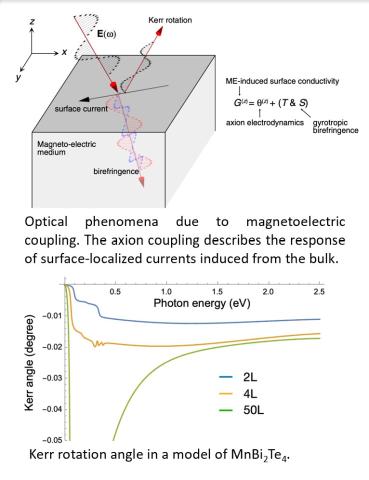Understanding the unique response properties of magnets can lead to significant impacts on physical sciences and technology. Unlike ferromagnets where properties strongly couple to a material’s magnetization, however, electromagnetic response properties unique to antiferromagnets, which have no net magnetization, are rarely known. This presents both challenges and opportunities; while antiferromagnets are hard to detect and manipulate, they are robust against external perturbations – making them attractive as repositories of information.
Magneto-electric effects have recently arisen as ways of utilizing magnets beyond the direct coupling between net magnetic moment and magnetic field. CATS focuses on the discovery of new phenomena in magnetic topological materials with a key objective to understand magneto-electric coupling in novel antiferromagnetic axion insulators. However, the magnitude of the axion magneto-electric coupling is not uniquely defined in lattice systems, which prohibited systematic theoretical understanding of the electromagnetic phenomena at optical frequencies.
magnetic moment and magnetic field. CATS focuses on the discovery of new phenomena in magnetic topological materials with a key objective to understand magneto-electric coupling in novel antiferromagnetic axion insulators. However, the magnitude of the axion magneto-electric coupling is not uniquely defined in lattice systems, which prohibited systematic theoretical understanding of the electromagnetic phenomena at optical frequencies.
In this work, we present a theoretical breakthrough in overcoming this challenge. We define a calculable and physically meaningful axion coupling from the response of the surface current. With this theoretical advance, we calculate the effect of magneto-electric coupling on the transmission and reflection of light. We show that a significant Kerr effect is possible at optical frequencies in fully compensated topological antiferromagnets due to the axion magneto-electric coupling.
Our results allow a systematic analysis of the optical detection and manipulation of antiferromagnets that have broad applications in physical sciences and may be used in spintronics.
Publication link
“Theory of optical axion electrodynamics and application to the Kerr effect in topological antiferromagnets," Junyeong Ahn, Su-Yang Xu & Ashvin Vishwanath.
Nature Communications 13, 7615 (2022). https://doi.org/10.1038/s41467-022-35248-8
All funding acknowledgment details
This work was supported by the Center for Advancement of Topological Semimetals, an Energy Frontier Research Center funded by the U.S. Department of Energy Office of Science, Office of Basic Energy Sciences, through the Ames Laboratory under contract No. DE-AC02-07CH11358.
